► Lotus Evija: the £2.4m electric hypercar
► Testing regime continues in Norfolk, Middle East
► Chinese owner Geely backs new initiative
The Lotus Evija hypercar test programme continues – and so does the drip-feed PR campaign designed to keep us talking about Hethel’s new electric supercar ahead of a planned launch in 2020.
The company has released detailed testing notes from Gavan Kershaw, Lotus’s stalwart test driver and finesser of many years standing. He’s responsible for the feel of the new EV hypercar and claims they’re developing it ‘naked’ – without any safety systems – at present, so they can get the pure handling right before any electro-nannies are deployed. It’s a clever way of getting that characteristically connected Lotus feeling.
‘It means we can really read the car,’ he said. ‘Later we can tune what we’ve gained as a mechanical advantage as we add layers. It’s the Lotus way – get the fundamentals right from the start and use baseline aerodynamics, suspension kinematics and geometry to feel the vehicle’s response.’
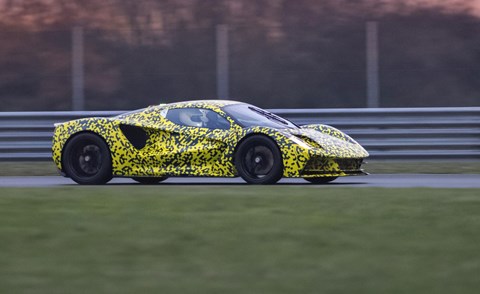
Elements like active aerodynamics are being high-speed tested at the Hethel proving ground in Norfolk (above), where the carbonfibre supercar is being put through its paces. There are three prototypes and #2 is the most advanced test hack, with production e-powertrain, brakes, suspension and bodywork.
‘Lotus has always been about ‘input = output’, so if you do something you get a response, and that’s what we’re balancing now,’ added Kershaw. ‘It’s all about the detail so, for example, we’re validating the progressive response from the pedals. We know there’s an enormous amount of torque but drivers will only want it when they ask for it with their right foot. It’s about getting that throttle balance right.
‘It’s really exciting for me. I love this part of developing any Lotus because it’s proving the mechanical design and the physics behind everything is right, and then working with our engineers to enhance the experience and give the car a true Lotus character. It’s the step-by-step stuff we do with every Lotus – Evija is no different.’

High-speed testing takes place after extensive computer simulations of the new car, and will be followed by months of further endurance testing and driving assessment, using several prototypes.
Lotus Evija: everything you need to know
Meet the Lotus Evija: the first all-new product from Hethel in over a decade, and its first under Geely ownership. Originally codenamed the Type 130, the Lotus Evija is an EV with sci-fi looks and equally outrageous performance. Lotus will produce just 130 examples, and it’ll cost around £2.4 million when deliveries begin in 2020.
If you want one, a £250,000 deposit will secure prospective customers a build slot. Lotus Evija: everything you need to know
The Evija – pronounced ‘E-vee-ya’ and meaning ‘the first in existence’ or ‘the living one’ – is the first fully electric supercar from an established sports car marque and the most powerful, too. With a target power output of 1973bhp, the Lotus could edge out the Pininfarina Battista’s 1900bhp by a decent sum – and a kerbweight of 1680kg combined with 1254lb ft torque means it’ll be super-quick, too.
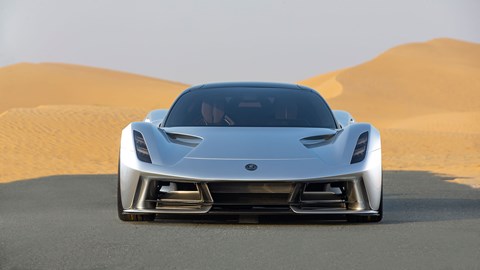
Lotus is targeting a sub-3.0 second 0-62mph launch, with 186mph from a standstill arriving in just nine seconds. Some context; a new Ferrari SF90 Stradale will do 0-62mph in 2.5 seconds, while a McLaren Speedtail will do 0-186mph in 12.8sec. The Evija will have a 200mph-plus V-max, Lotus claims.
‘There is a limit to how much power you can communicate through tyres to any given road surface,’ says Lotus’s principal platform engineer, Louis Kerr. ‘If you had race slicks on race tarmac, you can get something even more special. But put it on the A11 on road tyres, and there is a limit.’

What’s powering the Lotus Evija?
Although now under the ownership of Chinese car manufacturing giant Geely – which also owns electrified brands Polestar and Geometry – Lotus has tapped Williams Advanced Engineering for the Evija’s powertrain. The tech and business arm of the Grove F1 team already has significant experience with electric motors: it designed the battery used in the first four seasons of Formula E.
Unlike most other EVs we’ve seen, the Evija eschews a skateboard solution for the batteries, and instead pushes the lithium-ion unit low and behind the passenger compartment. Power gets to the road via an electric motor for each wheel, and that means all-wheel drive and torque-vectoring – both essential when managing 1254lb ft of torque.

The Lotus should keep going, too: range is a claimed 250 miles on the more rigorous WLTP test cycle, and that performance should be accessible at any time. ‘The battery won’t de-rate [suffer range collapse] in normal track driving, unlike nearly all other high-performance electric cars,’ Kerr reassures us.
The looks
The Lotus Evija’s design is quite arresting from some angles: half traditional supercar (especially in side profile) and half outrageous hypercar with mad detailing (check out those massive rear air scoops). It’s built around a rigid carbonfibre monocoque – the first on a roadgoing Lotus – around which they’ve shrink-wrapped an extreme, downforce-led design that looks unlike anything else on the road.
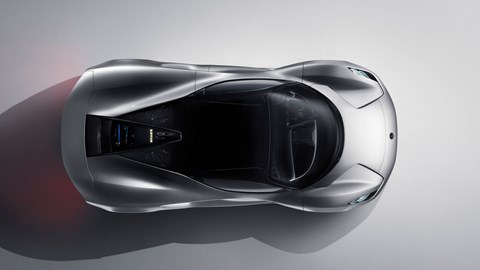
The Evija looks fairly conversative from the front: stacked headlights, and cooling ducts feeding air to that Williams-sourced battery, but as your eye settles towards the rear, things take a more innovative twist.
Like most contemporary hypercars, the surfaces of the Evija have been designed to produce as much downforce as possible, but unlike most rivals it doesn’t have a traditional drivetrain and associated paraphernalia an ICE needs. That meant Lotus was able to try some serious new techniques to squeeze and shave weight from its new hypercar.
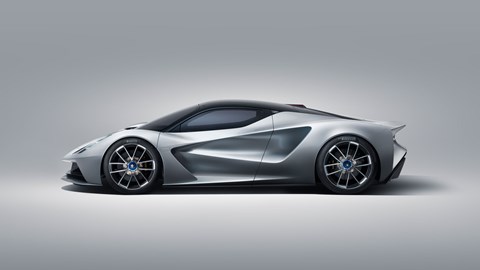
‘The electric powertrain gave us more design freedom and aerodynamic advantages,’ designer Russell Carr explains. ‘There is a huge available area for creating downforce, and lots of free-flowing air to reduce drag.’
Alongside the usual formula of huge diffuser and flat floorpan, the Lotus Evija achieves extra downforce through two aero tunnels that channel air not over but through the car. Just as F1 designers clear space in front of the diffuser and rear wing to generate cleaner free air flow, so Lotus has essentially done the same thing by boring two tunnels through the bodywork. The rear lights are then wrapped around those tunnels for a futuristic look, while the light-up Lotus badging across the rump doubles as a reversing light.
In addition to this sculpted bodywork, the Evija will also deploy a huge old-fashioned rear wing when needed, and it also uses a drag reduction system (DRS), like an F1 car.
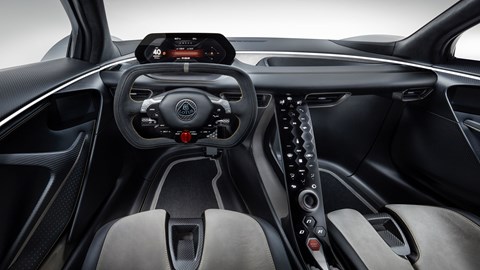
Inside the Evija’s forward-facing, teardrop-shaped cabin, Lotus has fashioned a skeletal arrangement of carbonfibre beams that hold everything a driver would need close to hand. Although futuristic, it’s where Lotus’s age-old lightweighting ethos is most evident. There’s a flat-bottomed F1-style wheel with a range of modes – Eco, City, Tour, Sport and Track – and OLED screens on the doors stream footage from the wing-mounted cameras. And interestingly, there’s no touchscreen in sight, with Hethel wanting to maintain a pure, uninterrupted driving focus.
What’s next?
The Evija is going to be Hethel’s halo product, and it’ll be followed by a refreshed, then expanded range of Lotus cars – all of which will borrow elements of its design language. Get ready for a 2020s version of the Elan, and then a Chinese-made SUV after that.
Sounds like Lotus is about to enter the most intriguing phase of expansion ever under Geely’s ownership – a feat few would have dreamed possible after the Dany Bahar years of failed dreams.